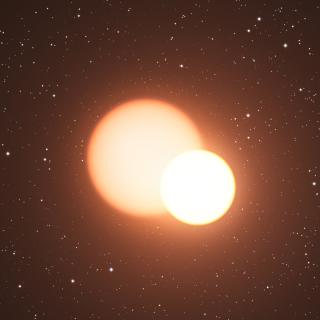CHEOPS, the new exoplanet mission of the European Space Agency (ESA), in which the Instituto de Astrofísica de Canarias (IAC) is participating, has observed a nearby planetary system which contains one of the hottest and most extreme extrasolar planets known until now: WASP-189 b. The result, the first from this mission, is being published in Astronomy & Astrophysics.
CHEOPS, launched in December 2019, is a satellite designed to observe nearby stars known to have planets, and to characterize them. By measuring with great accuracy the changes in the light levels coming from stars which have orbiting planets, CHEOPS can first measure the properties of the planets and help us to understand how they formed and evolved.
The planet observed is a an “ultrahot Jupiter” called WASP-189 b. Hot Jupiters, as their name implies, are gas giant planets similar to our own Jupiter, but which orbit their host star at a much closer distance, so they are at much higher temperatures.
WASP-189 b is some 20 times nearer to its star than the Earth is to the Sun, and completes its orbit in only 2.7 days. Its host star is bigger, and over 2,000 degrees hotter than the Sun, so it is a blue star. “There are only a few planets around stars which are so hot and this system is, by far, the brightest” –points out Monika Lendl, a researcher at the University of Geneva, in Switzerland, and the first author of the article-. WASP-189 b is also the brightest hot Jupiter that we can observe when it passes in front of or behind its star, which means that the complete system is really interesting”.
The researchers first used CHEOPS to observe an occultation of WASP-189 b while it passed behind its host star. “As the planet is so bright, there was a noticeable fall in the light which we measure from the system when it is briefly out of sight”, explains Lendl. We use this to measure the brightness of the planet, and estimate its temperature at a roasting 3,200 degrees Celsius”. At that temperature even metals such as iron melt, and even vaporize, which means that the planet is obviously uninhabitable.
After that, CHEOPS observed the transit of WASP-189 b in front of its star. These transits can reveal a lot about its size, its shape, and the orbital elements of a planet, which was the case with WASP-189 b, which turned out to be bigger than previously thought, with almost 1.6 times the radius of Jupiter.
“We also see that the star itself is interesting: it is not perfectly round, but bigger and cooler at its equator than at its poles, so that the poles of the star appear brighter”, notices Roi Alonso, an IAC researcher and a co-author of the article. “It is rotating so quickly that it is being pushed outwards at its equator. As well as this asymmetry, the orbit of WASP-189 b is inclined, it does not orbit around the equator but passes close to the poles of the star”.
To find such an inclined orbit adds to the mystery of how hot Jupiters form. In order for a planet to have such an inclined orbit it must have formed further away from its star, and then been pushed inwards. We think that this happens when several planets within a system are jostling for position, or when they are subject to an external forcé -perhaps due to another star-, which perturbs the system and pushes the gas giant towards its star, and into much tighter, more inclined orbits. “Measuring this sort of inclination for WASP-189 b with CHEOPS –points Alonso- suggests that it has undergone this type of interaction in the past”.
“This first result from CHEOPS is tremendously exciting: a first clear proof that the mission is fulfillng its promise in terms of accuracy and achievement”, states Kate Isaac, ESA’s project scientist for CHEOPS.
“CHEOPS must play a unique role in the study of exoplanets”, stresses Enric Pallé, an IAC researcher and a co-author of the article. “It will look at transits of planets which have already been discovered from the ground and, whenever posible, will measure with increased accuracy the sizes of planets which we know transit their host stars. By tracking exoplanets in their orbits with CHEOPS, we can make a first characterization of their atmospheres and determine the presence of clouds and their properties”.
In the coming years, CHEOPS will follow hundreds of known planets which orbit bright stars, taking advantage of, and adding to what has been done with WASP-189 b. The mission is the first in a series of three scientific missions by ESA whose goal is the detection and characterization of exoplanets. It also has an important potential for discovery, from the identifications of key objectives for future misions which will explore exoplanetary atmospheres, to the search for new planets and exomoons.
“CHEOPS will not only deepen our understanding of exoplanets, but will also help us to understand our own planet, our Solar System, and the cosmic environment in general”, concludes Pallé.
Article: Lendl et al. “The hot dayside of WASP-189 b and its gravity-darkened host star seen by CHEOPS”, Astronomy & Astrophysics. DOI: https://www.aanda.org/10.1051/0004-6361/202038677
Contact at the IAC:
- Roi Alonso: ras [at] iac.es (ras[at]iac[dot]es)
- Enric Pallé: epalle [at] iac.es (epalle[at]iac[dot]es)



